1/"You can put this diagnosis in the differential as many times as you want in your life, but you will only be right once," I told my fellow.
A🧵about a dx you hear about but are rarely lucky enough to see #medtwitter #FOAMed #FOAMrad #medstudent #neurorad #radres #neurosurgery
A🧵about a dx you hear about but are rarely lucky enough to see #medtwitter #FOAMed #FOAMrad #medstudent #neurorad #radres #neurosurgery

2/Pt had a calcified lesion in the posterior fossa found incidentally on a trauma CT, that was now enlarging. It had very coarse, stippled appearing calcifications, like grains of sand or dirt 

3/It also had very jagged, irregular margins, almost as if the grains of calcium had just been piled up together haphazardly 

4/On MRI, it was very T2 dark (from the calcs) & demonstrated mild enhancement. It was extraaxial, but didn't appear to arise from the meninges. Rather, it was in the lateral cerebellomedullary cistern, where CN 9-11 arise. 

5/So went back to the CT--left SCM & trapezius atrophy but no cord palsy! This means it's a CN11 lesion--not just affecting it from mass effect, then it would affect 10 also. Calcified schwannomas are rare. CN11 schwannomas are rare. Calcified CN11 schwannomas likely don't exist 

6/Googling "calcified lesion CN11" gave us CAPNON--a rare, non-neoplastic, reactive process. It affects CNs & when it does, usually 11.We were right! So I've had my 1 time to be right about this. If you haven't, now you know what to look for to make this dx a feather in your CAP! 

• • •
Missing some Tweet in this thread? You can try to
force a refresh






















